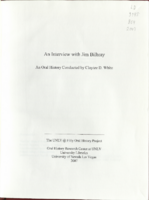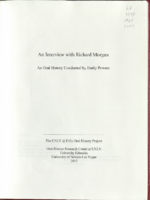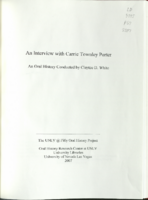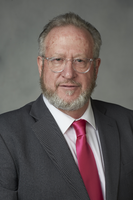Search the Special Collections and Archives Portal
Search Results

Transcript of interview with Jim Bilbray by Claytee D. White, September 6, 2006
Date
2006-09-06
Archival Collection
Description
Jim Bilbray was born right here in Las Vegas. He attended school here through graduation from Las Vegas High School. As a high school student, he helped collect money to buy the first land on which to build what later became UNLV. After a stint in the National Guard, he enrolled at BYU in Provo for one quarter, and then began attending classes at UNLV. Jim served as student body treasurer at UNLV for one year, and was then elected student body president. He also played on the first tennis team, was a back-up player on the first basketball team, and bowled on the bowling team. In 1959, he transferred to American University in Washington, D.C., graduating with a degree in government and public administration. He then went to law school. In 1965, Jim returned to Las Vegas, looked up some of his old friends, and concluded that they needed to form an alumni association. They created a nonprofit corporation which they named the Nevada Southern Alumni Association. At age 29, he agreed to run for a position on the Board of Regents, and won. His was the key vote which resulted in funding for the Humanities Building. Mr. Bilbray recounts many stories of the early struggles and downright hostilities between UNR and UNLV, struggles over budget, professional schools, and priority lists for buildings. He also relates the efforts he and others made to obtain property for future campus growth, and agrees with Carol Harter's vision of a University mall.
Text

Transcript of interview with Richard Morgan by Emily Powers, November 7, 2006
Date
2006-11-07
Archival Collection
Description
Richard Morgan was born in Fresno, California. His parents moved to the San Francisco Bay area a few months later, where Richard grew up and attended grade school and high school. His father had moved there for the express purpose of giving his children the opportunity to attend U.C. Berkeley. Richard did in fact graduate from Berkeley in 1967 with a degree in political science. After college, Richard married and he and his wife worked for a year to save money to send him to law school. His wife supported him while he studied law at UCLA Law School from 1968 to 1971. After graduation Richard worked for two different law firms, eventually choosing Nausaman and Waters, Scott, Kruger & Reardon. He worked there for 9 years, making partner in 1977. In 1980, Richard left the law firm to teach corporations and commercial law at Arizona State University in Tempe, Arizona. For three years he was an associate professor, and in 1983 was asked to take the position of associate dean. He accepted and held that position for four years. He then became dean at the University of Wyoming College of Law in Laramie, Wyoming. After 2 !/2 years, he was asked to return to ASU as dean of the law school, where he worked for 7 years. In 1997, Richard learned that UNLV was planning to start a law school. Remembering the advice of friends Booker Evans and Willard Pedrick to seize the opportunity to be a founding dean, he applied for the job. He met with Rick Brown, Christine Smith, Mary Berkheiser, and Dianne Retsell to come up with a general strategy for building a law school. Rick became the founding law library director and is currently a professor of law, Christine is associate dean for student affairs and operations, Mary is a clinician and faculty member, and Dianne became Richard's executive assistant. Richard and the other founding members recruited quality faculty members and with Carol Harter's influence, Bill Boyd's support, and aggressive advertising, the law school took shape. They achieved provisional accreditation in 2000 and then full accreditation with the ABA in the summer of '02 after the school moved into its present facility. In January of 2004 the Boyd School of Law joined the Association of American Law Schools. Today UNLV's law school offers a night program, a clinical program, the Saltman Center for conflict resolution, and a lawyering process program. The school is well known in the community and has become the community resource the founding members envisioned it to be. Richard believes the school will continue as it was begun—with an emphasis on excellence and progress.
Text
Super Bowl XXIII: San Francisco 49ers vs. Cincinnati Bengals, Miami, Florida: panoramic photograph, 1989 January 22
Level of Description
Item
Archival Collection
Bob Paluzzi Panoramic Photographs
To request this item in person:
Collection Number: PH-00414
Collection Name: Bob Paluzzi Panoramic Photographs
Box/Folder: Box 16, Digital File 00
Collection Name: Bob Paluzzi Panoramic Photographs
Box/Folder: Box 16, Digital File 00
Archival Component
Super Bowl XXIII: San Francisco 49ers vs. Cincinnati Bengals, Miami, Florida: panoramic photograph, 1989 January 22
Level of Description
Item
Archival Collection
Bob Paluzzi Panoramic Photographs
To request this item in person:
Collection Number: PH-00414
Collection Name: Bob Paluzzi Panoramic Photographs
Box/Folder: Box 16, Digital File 00
Collection Name: Bob Paluzzi Panoramic Photographs
Box/Folder: Box 16, Digital File 00
Archival Component
Super Bowl XXIII: San Francisco 49ers vs. Cincinnati Bengals, Miami, Florida: panoramic photograph, 1989 January 22
Level of Description
Item
Archival Collection
Bob Paluzzi Panoramic Photographs
To request this item in person:
Collection Number: PH-00414
Collection Name: Bob Paluzzi Panoramic Photographs
Box/Folder: Box 21, Digital File 00
Collection Name: Bob Paluzzi Panoramic Photographs
Box/Folder: Box 21, Digital File 00
Archival Component
Super Bowl XXIII: San Francisco 49ers vs. Cincinnati Bengals, Miami, Florida: panoramic photograph, 1989 January 22
Level of Description
Item
Archival Collection
Bob Paluzzi Panoramic Photographs
To request this item in person:
Collection Number: PH-00414
Collection Name: Bob Paluzzi Panoramic Photographs
Box/Folder: Box 21, Digital File 00
Collection Name: Bob Paluzzi Panoramic Photographs
Box/Folder: Box 21, Digital File 00
Archival Component
Super Bowl XXIII: San Francisco 49ers vs. Cincinnati Bengals, Miami, Florida: panoramic photograph, 1989 January 22
Level of Description
Item
Archival Collection
Bob Paluzzi Panoramic Photographs
To request this item in person:
Collection Number: PH-00414
Collection Name: Bob Paluzzi Panoramic Photographs
Box/Folder: Box 21, Digital File 00
Collection Name: Bob Paluzzi Panoramic Photographs
Box/Folder: Box 21, Digital File 00
Archival Component

Transcript of interview with Carrie Townley Porter by Claytee D. White, February 7, 2006
Date
2006-02-07
Archival Collection
Description
Carrie Townley Porter, a 6th generation Texan, was born in Central Texas near present-day Fort Hood. Her father, a highway patrolman, was called into the Army Reserve in 1940 and spent some years moving around the country. At one point, his wife and children stayed in Belton, Texas tor three years because her father was transferred to places they couldn't go. Carrie finished high school in Austin, Texas, and attended two years at University of Texas in Austin. She left college to get married, and she and her geologist husband lived in Kansas, Oklahoma City, and Albuquerque. He took a job with the Atomic Energy Commission that required frequent trips to the Nevada Test Site, so the suggestion was made that they just move to Las Vegas. At this point they had three children with no reliable child care so Carrie became a housewife for a while. The Townleys lived a full and active life in Las Vegas and she eventually got hired as a substitute teacher. Carrie mostly subbed at Gibson Junior High School. She decided to finish her degree at Nevada Southern University (now UNLV) after her principal told her that if she could do that, he would have a job waiting for her. Several of the courses that Carrie took were Nevada history correspondence courses from UNR. These courses were prepared and graded by Dr. Russell Elliott. Carrie also fondly remembers two Nevada Southern history professors in particular, Dr. John Wright, whom she considered a mentor, and Rosemary Masick, who taught English history. After receiving her bachelor's, Carrie returned to teaching math at Gibson Jr. High. She started an archaeology club on her own and she and Russ Elliott started the first Trailblazer Club (junior history) in the state. She got students involved in the history of the Native Americans in the area and took them on field trips which gave them a chance to participate in a dig. Carrie has worked in Special Collections in the UNLV library as an archivist, with Sierra Pacific Power Company as a records analyst, and at Caesar's Tahoe as records administrator. She has also been very deeply involved with the Nevada Women's History Project since 1994. This group was responsible for the Sarah Winnemucca Statue Project, which placed a statue of this Native American in Washington, D.C., and a copy of it in the capitol building in Carson City. Today Carrie is doing a collaborative book on Helen J. Stewart with Sally Zanjani. She has done extensive research on Helen Stewart's life, and to this day makes "living history" presentations dressed as Helen J. Stewart. In addition to her history commitments, Carrie still holds onto her records management consulting firm, which she started in 1985.
Text
#72204: Isaiah Henry participated in the McNair summer research program. His current project involves developing a more stable perovskite phase for solar cells, 2018 August 06
Level of Description
Item
Archival Collection
University of Nevada, Las Vegas Creative Services Records (2010s)
To request this item in person:
Collection Number: PH-00388-05
Collection Name: University of Nevada, Las Vegas Creative Services Records (2010s)
Box/Folder: Digital File 01
Collection Name: University of Nevada, Las Vegas Creative Services Records (2010s)
Box/Folder: Digital File 01
Archival Component

UNLV Harrah Hotel College professor Carl Braunlich poses April 22, 2015 at the University of Nevada, Las Vegas: digital photographs
Date
2015-04-22
Archival Collection
Description
Photographs from the University of Nevada, Las Vegas Creative Services Records (2010s) (PH-00388-05). Client: Hotel College
Image
Pagination
Refine my results
Content Type
Creator or Contributor
Subject
Archival Collection
Digital Project
Resource Type
Year
Material Type
Place
Language
Records Classification
